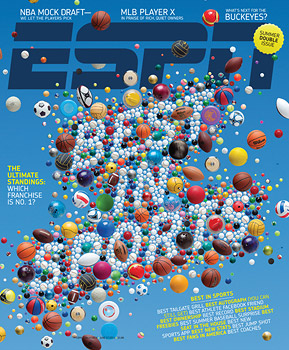How bad is it in the magazine world? Two years ago we bought a subscription to ESPN magazine after finding a promotional offer of 26 issues for just $2. We subscribed simply for the experience of getting a fortnightly magazine for less than the cost of postage.
But it turns out we were getting a lot more than just ESPN. Around the time our subscription expired, we started getting Golf magazine every month in the mail. Golf’s promotional price is $10 a year, but we never paid for or requested a subscription. Then, about three months ago, Sports Illustrated began showing up in our mailbox each week. We like that because we’ve actually paid for Sports Illustrated in the past. However, we aren’t paying for this one. It appears to be another side=benefit of our $2 ESPN deal.
We’re not sure if this embarrassment of riches is at an end, but we do know that altogether we’re receiving about $70 worth of magazine subscriptions for $2. Why? Because the publishers are desperate. New Audit Bureau of Circulations rules have significantly relaxed the criteria for paid circulation. That means the publisher statements for Golf and Sports Illustrated now count us as subscribers despite the fact that we never requested or paid for either subscription. Any advertiser that thinks it’s getting an engaged audience through this accounting sleight-of-hand is fooling itself. Don’t get us wrong: We hope the SI subscription never runs out, but we are never, ever going to pay for it. Are we as valuable to an advertiser as a paying subscriber? Not so much. Is the print magazine industry in a crisis? We think so. BTW, we did not get the attractive tote bag that comes with a paid subscription..
Gannett Pounds 700 Nails in Print’s Coffin
If you need any further evidence that print has no future, look no further than Gannett’s announcement of 700 layoffs this week, says Poynter’s Rick Edmonds. Revenues at Gannett’s 81 community newspapers were down 7% overall and nearly 10% in print, even as most mainstream media are experiencing a modest recovery right now. Not so in print. Publishing operating margins fells four times as fast as revenues, and it’s been a decade since Gannett bought any print properties at all. Meanwhile, the company has reduced its stable of newspapers from 99 to 81. Its broadcast and online operations are actually doing just fine, but they’re not growing fast enough to make up for declines in print advertising. That’s the problem across the industry. Online revenues are growing, but the volume and margins are a tiny fraction of print revenue.
Gannett, which traditionally dances to the tune of Wall Street, is sending a message in aggressively cutting back on its already lean print businesses. In that respect, it’s ahead of the market. Edmonds points out that, ironically, “Metro papers like the Boston Globe and Dallas Morning News that have adopted a high price/high quality circulation strategy know readers will not be satisfied with skinny papers that have little worth reading. So those newsrooms are protected and, in a few cases, growing.” For a while, that is. Those papers are milking an aging but still profitable population that will dwindle sharply over the next decade. When the tipping point is reached and paid subscribers no longer justify a printed product, the closures will happen en masse.
Nonprofits Figuring It Out
We wrote recently about California Watch, a nonprofit investigative news operation that is breaking even by syndicating its content at low cost to dozens of news outlets to customize as they wish. California Watch and others like it understand the economics of multiple revenue streams. Few newspapers can afford to support large investigative reporting staffs, but a bunch of smaller publishers can collectively contribute enough to make an independent investigative team viable.
 California Watch isn’t the only outlet breaking new ground in this area. Writing on Nieman Journalism Lab, Justin Ellis tells the story of New England Center for Investigative Reporting, another nonprofit operation that is surviving on a combination of grants and revenue from paid training workshops for aspiring journalists. The group has only two full-time staff and a corps of freelancers. It delivers its investigative work via a subscription service and republishes them on its website. The Center recently reached a milestone by matching its grant funds with revenue generated from subscriptions and training, meaning it’s on the road to self-sufficiency.
California Watch isn’t the only outlet breaking new ground in this area. Writing on Nieman Journalism Lab, Justin Ellis tells the story of New England Center for Investigative Reporting, another nonprofit operation that is surviving on a combination of grants and revenue from paid training workshops for aspiring journalists. The group has only two full-time staff and a corps of freelancers. It delivers its investigative work via a subscription service and republishes them on its website. The Center recently reached a milestone by matching its grant funds with revenue generated from subscriptions and training, meaning it’s on the road to self-sufficiency.
Co-director and veteran New England TV reporter Joe Bergantino (left) says, “To be successful you have to walk through the door and immediately think about how to make money.” And what’s wrong with that? For the last 50 years or so, journalists have had the luxury of having the bills paid by people they don’t even know. Very few businesses operate that way, so Bergantino and his tiny team are simply functioning by the same rules that small businesses have lived with for years. Does that make the quality of their work less reputable?
Got HTML5?
 The Financial Times’ new mobile app racked up 100,000 users in its first week. The twist is that the FT decided to develop the app in the new HTML5 format instead of coding it for the iPad or Android platform. If you don’t know what HTML5 is, here’s a tutorial. It’s an important new technology that could make Flash animation and other plug-in-based multimedia obsolete.
The Financial Times’ new mobile app racked up 100,000 users in its first week. The twist is that the FT decided to develop the app in the new HTML5 format instead of coding it for the iPad or Android platform. If you don’t know what HTML5 is, here’s a tutorial. It’s an important new technology that could make Flash animation and other plug-in-based multimedia obsolete.
HTML5 works entirely within the browser and gives the publisher considerably more control over display, organization and animation than earlier HTML versions did. Information can be stored and read offline, as well as updated automatically without user intervention (No more Adobe updates; how cool is that?) The trick is that most browsers don’t fully support it yet, but that’s just a matter of time. Apple’s Safari is one of the best browsers for HTML5 apps. That’s not surprising, given that Steve Jobs has engaged in a bitter public dispute with Adobe over Flash. The downside for Apple is that HTML5 enables publishers to deliver apps themselves without using the iTunes store as an intermediary. That’s why the FT is updating its content directly, without going through the iTunes store. HTML5 will also make it easier for publishers like Playboy, whose content wouldn’t make it past the Apple censors, has also gone the HTML5 route.
Miscellany
If you’ve ever wondered whether the image you’re about to publish has been Photoshopped, try out this new service from Google. Upload or type the URL of an image and Google will now scan its database for images just like it – including the exact same image. We’re not sure what it will find if given a photo of one of Lady Gaga’s dresses, but for those beautiful sunset landscapes that come in from “citizen journalists,” it might be worth a try, just to be safe.
Meredith is closing the hip, do-it-yourself magazine ReadyMade and eliminating 75 positions. Apparently an audited circulation of 335,000 wasn’t enough to attract advertisers.
John Locke has become the first self-published author to sell over 1 million books on Kindle. The 60-year-old Louisville, KY resident has written nine novels, mostly thrillers, and charges only 99 cents for the Kindle versions. He says he has no intention of raising his prices. Having brought in about a million dollars this way, Locke is making a decent income for a novelist, especially since he doesn’t have to pay publisher and distributor costs that typically leave the author with only about 10% of a book’s cover price.
In deference to Huffington Post, The New York Times plans to intermingle news and opinion in its “Week in Review” section, saying, “We thought readers would find it more useful to have the stories, photographs and charts offered in an integrated way.” Back in the day, op-ed sections themselves were controversial. Now they will be indistinguishable, although the Times says it will clearly label opinionated content.
And Finally…
 This one is almost too bizarre to be believed. A couple weeks ago, it was revealed that a popular Syrian lesbian blogger who went by the name of “A Gay Girl in Damascus” is actually a 40-year-old married dude from Scotland. Despite the fact that gay activists in Syria believe this guy put their safety at risk, he continues to blog under the pseudonym, although he did post a profuse apology for the ruse.
This one is almost too bizarre to be believed. A couple weeks ago, it was revealed that a popular Syrian lesbian blogger who went by the name of “A Gay Girl in Damascus” is actually a 40-year-old married dude from Scotland. Despite the fact that gay activists in Syria believe this guy put their safety at risk, he continues to blog under the pseudonym, although he did post a profuse apology for the ruse.
The very same week, a guy in Ohio named Bill Graber admitted that he is Paula Brooks, an executive editor for lesbian site LezGetReal.com. Graber used his wife’s name in the hoax and even posed as the father of the fictitious blogger for media interviews, claiming Paula is deaf. Graber got away with hoax for three years because he was so believable, according to LezGetReal’s managing editor.
It gets even weirder. Quoting the account in StinkyJournalism.org:
Months ago, Graber, posing as “Paula Brooks,” reportedly encouraged “Amina Arraf” to start a blog, but neither Graber nor MacMaster knew the other was really a man posing as a lesbian woman online. According to the Washington Post, Arraf and Brooks “often flirted” with each other online as well.
This week, after both hoax identities unraveled, Graber described his interactions to the Washington Post with Arraf/MacMaster as a “major sock-puppet hoax crash into a major sock-puppet hoax.”
We can only hope neither sock puppet survived the collision.





